
A fire engine operated by the London Fire Brigade in the United Kingdom
A fire apparatus (also known in some territories as a fire engine, fire truck, or fire appliance) is a vehicle designed to assist in firefighting and other rescue operations. Its functions include transporting firefighters to the scene of a fire, along with water and other equipment. In some territories, the terms fire engine and fire truck may represent different types of fire apparatus.
A typical modern fire apparatus carries equipment for a wide range of firefighting and rescue tasks. These include ladders, pike poles, axes and cutting equipment, halligan bars, ventilating equipment, floodlights, hose ramps, self-contained breathing apparatus, and general tools.
Many fire apparatus are based on standard truck or lorry models with heavy duty suspension, alternators, transmission and cooling systems; audible and visual warnings such as sirens, horns, and flashing lights are added, as well as communication equipment such as a two-way radio.
Fire aparatus are often adapted to their areas of operation. Fire departments covering metropolitan areas or regions with additional fire risks may operate additional specialist vehicles for dealing with hazardous material incidents, fires requiring major foam attacks and multiple hose laying, as well as urban search and rescue and water rescues. In rural areas, fire departments may operate all-terrain apparatus. Depending on the local geography, fire-trains, fireboats or airplanes may also be used. In addition to apparatus designed specifically to fight fire, many fire departments also operate rescue units that carry tools for technical rescues of people from traffic collisions or structural collapses.
Types[]
| Wikimedia Commons has media related to: [[Commons:Category: Category:Fire engines | Fire engines
]] |
Conventional fire apparatus[]
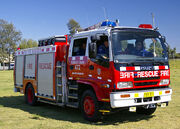
A conventional pumper of the Fire and Rescue NSW in Wagga Wagga, Australia
The conventional fire apparatus (also called a fire appliance, fire tender, fire engine, water ladder, pumper or pump-ladder) may have several methods of pumping water onto the fire. The most common method is to pass water from a pump through hoses to the fire, from an array of valves. It may also have a fixed pumping "cannon" (also called a fire monitor or deck gun), which can direct the water as pointed by the operator. The horizontal and vertical range of the monitor arrangement usually is limited and appropriate only for specific tasks, such as airport fires. Monitors can also be used as water cannons for crowd control. A fire engine may have an onboard water reservoir allowing firefighters to begin tackling the fire immediately or it may be completely reliant on external sources, such as fire hydrants, water tenders, natural sources such as rivers, or reservoirs by using draft water suction. A development is the use of an impulse fire-extinguishing system (IFEX), in which the water is highly pressurized into a vaporous mist, creating a cooling effect that is more efficient than that of water alone.[1] Some fire engines have been equipped with injectors for mixing foam into the pumped water stream creating a foam solution that is more effective than water alone. Some modern apparatus have included an air pump alongside foam injection to produce a compressed air foam product that further increases the efficiency of the water stream, cutting down dramatically on extinguishing time and water damage. This is referred to as a CAFS (compressed air foam system).
Aerial apparatus[]
Turntable ladder[]
| Wikimedia Commons has media related to: [[Commons:Category: Category:Turntable ladders | Turntable ladders
]] |
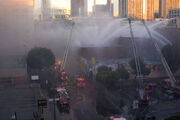
Several aerial apparatus in use at a fire in Los Angeles
A turntable ladder (TL) is perhaps the best-known form of special purpose aerial apparatus, and is used to gain access to fires occurring at height using a large telescopic ladder, where conventional ladders carried on conventional appliances might not reach.
The name is derived from the fact that the large ladder is mounted on a turntable on the back of a truck chassis, allowing it to pivot around a stable base, which in turn allows a much greater ladder length to be achieved. To increase its length, the ladder is telescopic. Modern TLs are either hydraulic or pneumatic in operation.
A ladder can also be mounted behind the cab. This is sometimes called "mid-ship" and the arrangement allows a shorter wheelbase for the truck, and also can be more stable in some conditions.
The key functions of a turntable ladder are:
- Allowing access or egress of firefighters and casualties at height;
- Providing a high level water point for firefighting (elevated master stream);
- Providing a working platform from which tasks such as ventilation or overhaul can be executed.
While the traditional characteristic of a fire appliance was a lack of water pumping or storage, many modern TLs have a water pumping function built in (and some have their own onboard supply reservoir), and may have a pre-piped waterway running the length of the ladder, to allow a stream of water to the firefighters at the top. In some cases, there may also be a monitor at the top of the ladder for ease of use. Other appliances may simply have a trackway which will hold a manually run hose reel securely, and prevent it from falling to the ground.
Tower ladder[]
Some turntable ladders may have a basket (sometimes known as a bucket) mounted at the top of the ladder, as on a hydraulic platform; these are called tower ladders. These appliances can provide a secure place for a firefighter to operate equipment from, and allow multiple people, including rescued persons, to be carried.
Tiller ladder (Hook-and-ladder)[]

A tiller ladder of the Los Angeles Fire Department manufactured by American LaFrance
A tiller ladder, also known as a tractor-drawn aerial, aerial ladder truck or hook-and-ladder truck, is a specialised turntable ladder mounted on a semi-trailer truck. It has two drivers, with separate steering wheels for front and rear wheels. This truck is primarily used in the United States, especially in cities—like San Francisco and Washington, DC—where narrow streets cannot be entered by longer, rigid-bodied trucks. City Service Truck was the predecessor to the modern tiller ladder in that there was no aerial turntable ladder mounted. Only ground ladders were carried on a City Service Truck. The 65 ft. (bangor pole, tormentor pole or stay pole) extension ladder was the longest wood ground ladder carried on the obsolete San Francisco Fire Department City Service Truck. Which is now only used for parade and antique 65 ft. extension ladder evolution displays.
The hook-and-ladder concept originated when taller buildings and narrow city streets became a problem for fire departments. Larger ladders were needed to get to the upper stories of buildings, and the only way to move these large ladders was with a large vehicle. However, the only way to position these ladders properly was with a highly maneuverable vehicle. The independent steering for the rear wheels improves maneuverability and allows the truck to quickly position itself for fighting fires.
The word hook in hook-and-ladder refers to the long-poled hooks, also called pike poles, carried on many types of fire fighting apparatus. Hooks and ladders, essential tools in fire fighting, were carried on fire trucks long before the development of the large tiller ladder trucks. The fire-fighting hook is used to penetrate and pull apart structure in the process of firefighting. In the US, tiller ladder trucks came to be called hook-and-ladder trucks, even though hooks and ladders are not their distinguishing features. At one time, there were two principle types of firefighting apparatus: one carried the pump and hoses, and the other carried the hooks and ladders.[2]
Quint/quad[]
- Main article: Quint (fire apparatus)
In some areas of the United States, the turntable ladder may be known as a quint or quad, as it is capable of performing multiple tasks (pump, water tank, fire hose, aerial device, and ground ladders) with each of these functions making up one of its four (Quad) or five (Quint) capabilities. The National Fire Protection Association (NFPA) has certain specification that a turntable ladder has to meet to be officially considered a quint or quad (such as fire pump capacity, minimum amounts of equipment, etc.).
Hydraulic platform[]
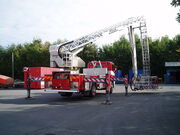
A telescopic hydraulic platform in Roskilde, Denmark
A hydraulic platform, also known as articulating booms, Snorkels, platform trucks, Bronto (used in Australia and New Zealand) or sometimes shortened to HP, is a specialized aerial work platform designed for firefighting use. They have a number of functions, which follow the same principles as the turntable ladder, providing high level access and elevated water pump positions.
Some hydraulic platforms are articulated, which allows the arm to bend in one or more places, giving it the ability to go "up and over" an obstacle (such as a building roof). There are non-articulated platforms, based on standard aerial work platforms, although the most common type is the tower ladder (mentioned above). HPs (articulated or not) may still have a ladder arrangement fitted to the arm, primarily as an emergency measure. In some jurisdictions these can be denoted ladder platforms.
Most HPs are designed to reach a height of around 33 metres (100 feet), although larger models are capable of reaching heights of over 100 metres (328 feet).[3]
Many HPs are fitted with additional equipment in the platform itself, which can include a control panel, lighting equipment, a fixed water outlet or monitor, power outlets or compressed air outlets (allowing the fixing of rescue equipment, such as hydraulic rescue tools). Many are also adapted or capable of carrying a stretcher. Some units have video systems and remote control in case of dangerous chemical fires.
In an emergency, liquid-concrete pumping boom trucks can be temporarily repurposed for delivery of water for firefighting, as in the case of the Fukushima Daiichi nuclear disaster in 2011.[4]
Aerial ladder platform[]
Some fire departments use aerial ladder platforms (ALPs), or aerial water towers, the purpose of which is to deploy an elevated master stream of water, although it does not provide any access for firefighters. In many departments however, this function is better performed by a HP or TL.
Rescue apparatus[]
Heavy rescue vehicle[]
- Main article: Heavy rescue vehicle
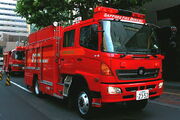
Heavy rescue vehicle with the Fire Bureau in Sapporo, Japan
A heavy rescue vehicle, sometimes referred to as a Rescue Company, Rescue Squad or Technical Rescue, is a type of specialty firefighting or EMS apparatus. Essentially giant toolboxes on wheels, they are primarily designed for technical rescue situations such as vehicle extrications following traffic collisions, confined space rescues, rope rescues, swiftwater rescues, or building collapses.
In the U.S., NFPA regulations 1006 and 1670 provide guidelines and regulations for the operation of heavy rescue vehicles and also state that all "rescuers" must have medical training to perform any technical rescue operation, including cutting the vehicle itself.[5][6] In most rescue environments, fire department personnel conduct rescue operations working hand-in-hand with medical personnel, such as EMTs or paramedics.
In addition to fire and rescue departments, tram or railway companies may have their own dedicated heavy rescue squads.[7][8] For example, railway rescue squads may carry very specialized equipment for railway accidents like hydraulic jacks with capacity for lifting locomotives or even moving them horizontally, and equipment for tank car accidents.[9]
Wildland fire apparatus[]
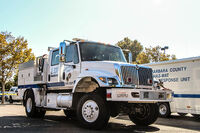
A Type 3 fire engine belonging to the Santa Barbara County Fire Department.
- Main article: Wildland fire engine
Wildland firefighting requires vehicles that can easily negotiate difficult terrain and high-gradient roads, be self-reliant, and have high clearances for wheels and suspension. These wildland fire engines are traditionally smaller than standard fire apparatus and are primarily used for vegetation fires or wildland fires. They may also respond to emergencies in rough terrain where other vehicles cannot respond. Most wildland engines feature four-wheel drive capability to improve hill climbing and rough terrain capability.[10] Some wildland apparatus can pump water while driving (where some traditional engines must be stationary to pump water), allowing "running attacks" on vegetation fires to minimize the rate of spread.[11]
Hazardous materials apparatus[]
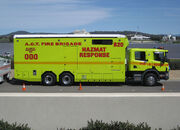
HAZMAT Response unit with the ACT Fire & Rescue Service in Canberra
Many fire departments covering large metropolitan areas or those containing many high-risk hazards keep specialist appliances for dealing with hazardous materials (HAZMAT). These are of several types, from those used to clean spilled oil on streets and highways, to full decontamination units, designed to clean victims and rescuers of contaminants after an incident.
Some fire departments may deploy a scientific support vehicle where required. Essentially a mobile laboratory, these units can attend a wide range of incidents, including chemical spills and fires, where early on-site scientific analysis and monitoring will speed up the detection process and allow firefighters and other emergency services to provide the correct response for the particular incident.
Logistical support apparatus[]
Many fire departments operate a number of vehicles in specialized logistical functions. These can be stand-alone vehicles, or may be modular, such as with the use of a hook-lift system. Hooklifts are sometimes only employed for seldom-used equipment; they can load a variety of different equipment containers very rapidly and act as a special unit with lower investment costs. For example, the Helsinki Rescue Department has several hooklift trucks and more than 40 containers, including a water container, a hose container, and an oil destruction container.[12] Containers may also carry a command post, salvage tools, foam barrels, hoses and pumps for wildfires, or even field hospitals.
Command support unit[]
| Wikimedia Commons has media related to: [[Commons:Category: Category:Firefighting command vehicles | Firefighting command vehicles
]] |
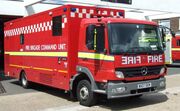
A London Fire Brigade Command Unit
The advancement of technology and potential for very large-scale incidents has led to many fire departments utilising or increasing their use of mobile command support units.
A fundamental advantage of such an appliance is to accommodate the many different types of communication equipment needed at major incidents. In addition to the wide range of radio frequencies used, fire chiefs often need to communicate via landlines and send and receive information via satellite links and CCTV of the ongoing situation. The command unit can essentially be used as an on-site conference centre for command personnel, mapping and planning firefighting operations and booking in and directing crews as they arrive.
Water and foam-carrying apparatus[]
Tanker truck[]
A tanker truck, which can also be known as a water tender or water bowser, is a specialist fire appliance with the primary purpose of transporting large amounts of water to the fireground to make it available for extinguishing operations. These are especially useful in rural areas where fire hydrants are not readily available and natural water resources are insufficient or difficult to exploit.
Most tankers have an on-board pumping system. This pump is often not of sufficient power to fight fires (as it is designed to be attached to a fire engine), but is more often used to draw water into the tender from hydrants or other water sources. In some areas, the tenders are used to pump water during floods, and may be fitted with a heavier duty pump for this purpose. Many tankers are equipped with fast-drain valves on the sides and back of the truck. This allows firefighters to empty thousands of gallons or several cubic meters of water into a portable water tank in just a few seconds.
Most water tenders are designed to carry loads of 1,000 US gallons (Template:Convert/L impgal) or more. In the U.S., 1,000 U.S. gallons is the requirement in the NFPA standards.[13] Some may carry up to or even upwards of 5,000 US gallons (Template:Convert/impgal L) of water.[14][15][16]
Hose layer[]
In some fire departments, a similar function may be performed by a hose layer, hose tender or hydrant tender which carries large-capacity high-pressure hose wagons to incidents where hydrants or other water sources are not close enough to the fireground. It will lay out its hose at the nearest hydrant or water source then drive to the fireground with the hose laying off the back; upon arrival it will connect to a fire appliance to supply it with the water needed for the firefighting operations.
Foam tender[]
Foam tenders carry large amounts of foam to be used at incidents where water is ineffective or cannot be used to tackle a blaze. They may take the form of a tanker, or a truck carrying foam packets or barrels.
Fireboat[]
Some fire departments that protect a body of water, such as a major city harbor or coastline, may utilise fireboats to combat fires on watercraft and waterfront areas. Such fireboats pump water from under them, so they can theoretically provide water indefinitely. In some places, fire boats are not just designed for firefighting, they can also be used to perform rescue missions, and transport divers and other equipment to the scene.
Fire train[]
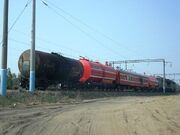
Fire train (foam-water tankers and pump-crew car) in Russia, hauled by a locomotive
Railways of the former Soviet Union widely use permanent-readiness fire trains to extinguish fires on the trains, railroad track and adjacent territories—which otherwise may not be accessible by the roads. A fire train consists of specialist railcars (i.e. water tank, foam tank, water pump, electric generator etc.) and a professional firefighting team. In case of fire emergency, the train is coupled by the nearest available locomotive and quickly routed to the emergency site beyond schedule. Despite fulfilling all the necessary railway procedures, the fire trains sometimes arrive at the site faster than the road vehicles, bringing more water supply to tackle the fire.
Each fire train has its permanent base siding with exits at both directions and adjacent buildings facilitating the team.[17] The base siding is always located in a major railway hub, where several locomotives are available at a time. e.g., there are two separate fire train units in the city of Kiev. However, fire trains in themselves are unlimited in their operation radius, protecting all the country's railways in a network pattern.
Similar trains are found in Switzerland, Germany and the United States (with BNSF).[18]
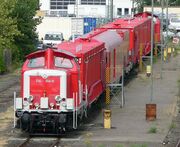
A German fire train of the Deutsche Bahn
Airport crash tender[]

Illustration of an airport crash tender using a puncture nozzle to spray inside of an airframe. At bottom-left is a closeup of the head of the nozzle showing the puncture nozzle (top), a standard nozzle (bottom), a light and a thermal imager (left and right)
An airport crash tender is a fire engine designed for use at aerodromes in aircraft accidents. The features include a good acceleration, ability to move on rough terrain outside the runway and airport area, large water capacity, a foam tank, a high-capacity pump, and water/foam monitors with a good throw distance. Newer AR-FF vehicles also incorporate twin agent nozzles/injection systems to inject a stream of Purple-K dry chemical into the AFFF Aqueous Film Forming Fluroprotein foam stream "knocking-down" the fire faster. Some also have Halotron tanks with handlines for situations that require a clean agent to be utilized. These features give the airport crash tenders a capability to reach an airplane rapidly, and rapidly extinguish large fires with jet fuel involved.
Some tenders have an elevated extended extinguishing arm called a Snozzle, giving a possibility to raise a water/foam cannon into the height of approximately . Some arms have reinforced nozzles that can puncture through superficial structures of an aeroplane to fight a fire inside the fuselage.[19]
The International Civil Aviation Organization (ICAO) has given standards and recommended practices on rescue firefighting categories of civil aerodromes.[20][21] National aviation authorities may have given even further requirements on aerodrome rescue and fire services.
The rescue fire services are based on a statistical analysis of movements (take-offs and landings) on the airport. The aerodrome category is based on the size of the biggest aircraft taking a movement on the aerodrome. In addition, the number of movements of the critical aircraft is calculated, and the category can be decreased by one if the number of movements is lower than the standard describes. There are also minimum category levels based on, for example, the number of seats in the critical aircraft.
Depending on the airport category, the standards determine the minimum number of rescue firefighting vehicles. In addition, requirements are given on the water and foam capacities, discharge rates for foam solutions, and minimum dry chemical powder (complementary agent) amounts, reserve stocks of fire fighting agents, ability to operate on rough terrain, and acceleration of the air crash tenders. The end of each runway must be reached in a response time of two minutes, and any part of the movement area has to be achieved in a response time not exceeding three minutes.
Aircraft[]
Fire departments may also deploy airplanes and helicopters to attack fire from the air. Such aircraft are fitted with large tanks that drop water or fire retardant chemicals onto the fire.
Firefighting tank[]
In China, a firefighting tank equipped with water and foam retardant guns is deployed in cases where access to the area is difficult.[22]
Motorcycle[]
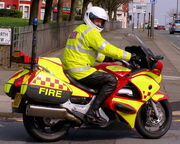
Fire bike with the Fire and Rescue Brigade in Merseyside, United Kingdom
Motorcycles are sometimes equipped for fighting fires or to be used as a first responder unit.
They are commonly used in Japan and Hong Kong, for example, in normal everyday duties. The motorcycles are useful for efficiently and quickly negotiating the small streets and heavy traffic in the large urban areas of Japanese cities. Having off-road motorcycles helps in responding to the difficult terrain that surround many urban centres. Some departments would likely have their crews in teams of two or three motorcycles. The firefighters who drive these motorcycles wear a light-weight fire suit. Their motorcycle's helmets are fireproofed and equipped with a radio. A fire extinguisher, fire blanket, and a small hose are carried in the cargo truck and panniers. One of the motorcycles carries a first aid kit and/or automated external defibrillator. The other motorcycles in this team may carry fire fighting and rescue equipment. A self-contained breathing apparatus pack is also carried aboard at least one motorcycle, and is kept ready for immediate use. Most crews are firefighters with training in first response, first aid, and/or paramedicine.
There are also fire fighting all-terrain vehicles.
In the Czech Republic, firefighters use a specially modified tank to extinguish forest fires.
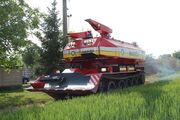
A tracked fire fighting vehicle in Slovakia
Other apparatus[]
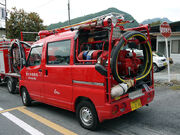
Kei car fire truck in Japan
Other fire apparatus include:
- Fire Police Unit
- Fire/Arson Investigation Unit
- Dive/Marine Rescue Unit
- Operational Support Unit
- Animal Rescue Unit
- Rescue and firefighting robot
- Crane trucks
- Hazmat trucks
- Squad/Utility Unit
- Tracked vehicle
- Other watercraft support such as rigid-hulled inflatable boats, hovercraft or hydrocopters
Other functions[]
In some communities a fire apparatus, often a paramedic engine, will be used to carry first responder firefighters, paramedics or EMTs to medical emergencies because of their faster response times due to forward staging in the city compared to ambulances coming from hospitals [23][24] Fire departments may also have lifeguards in places such as Los Angeles County, California.
Design and construction[]
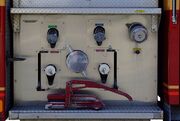
The discharge and intake valves on the side of a North American-type fire engine. In the UK, Ireland and Europe, these valves are generally at the rear of the vehicle and are known as deliveries and collectors respectively.
Many fire appliances around the world are based on standard truck or lorry models, which are upgraded to the specifications required by the purchasing department. In the United States, a majority of fire trucks are specially designed from the chassis to the cab and body. This has led to the use of the term custom fire truck, as opposed to a commercial chassis and cab.
A fire appliance may undergo modifications such as adjustments for higher durability, removal of any speed limiter, and adjustments for long periods of idling at a higher temperature. This may be accomplished by heavy duty suspensions, brakes, tires, alternator, transmission and cooling systems. It is also usual to upgrade the capacity of the electrical system to accommodate additional electrical and electronic equipment.
Fire appliances have audible and visual warnings, to protect themselves from traffic, and make themselves visible to other units at an incident.
In many countries, use of the audible and visual warnings affords the driver a degree of exemption from road traffic laws (such as the right to exceed speed limits, treat red stop lights as give way etc.) and may also infer a duty on other motorists to move out of the direction of passage of the fire vehicle (or face possible prosecution).
Visual warnings[]
Visual warnings on a fire appliance can be of two types: either passive or active.
Passive visual warnings[]
The passive visual warnings involve the use of high contrast patterns. Older vehicles (and those in developing countries) are more likely to have their patterns painted on, whereas modern appliances often carry retro-reflective designs which reflect light from headlights or torches. Patterns include "checker board" (alternate colored squares, sometimes called "battenburg markings", named after a type of cake), chevrons (arrowheads, often pointed towards the front of the vehicle if on the side, or pointing vertically upwards if on the rear) or stripes (along the side; these were the first type of retro-reflective devices introduced, as the original retro-reflective material came only in tape form). In some countries, in addition to retro-reflective markings, vehicles are now painted a bright yellow or orange, although in many other countries, red remains the color for fire engines. In Australia a number of rural fire units are painted white, such as those used by the Country Fire Service in South Australia, making them more visible in bushfire conditions.
Another passive marking is the word FIRE, RESCUE or local language variant spelled out in reverse on the front of the vehicle. This enables drivers of other vehicles to more easily identify a fire service vehicle in their rear view mirrors. The appliance may also display a telephone number which may be used to summon assistance, along with the name of the operating department or station identifier.
NFPA 1901 Standards for Automotive Fire Apparatus: 20.4 Aerial Ladder Operating Position
20.4.2 A system that is lighted and marked with labels shall be visible from the operator's position to indicate the elevation, extension, and rated capacities (see sample of boom angle indicator[25]).
Active visual warnings[]
Active visual warnings of a North American-type fire appliance
The active visual warnings are usually in the form of flashing colored lights (also known as "beacons" or "lightbars"). These flash to attract the attention of other road users as the fire appliance approaches, or to provide warning to motorists approaching a stopped appliance in a dangerous position on the road. Common colors for fire warning beacons are blue and red. The beacons can be made to flash. The original method was to place a spinning mirror which moves around a light bulb, called a "rotating beacon". More modern methods include the use of strobe lights, which are usually brighter, and can be programmed to produce specific patterns (such as a left -> right pattern when parked on the left hand side of the road, indicating to other road users that they should move out away from the vehicle). LED flashing lights are becoming more widespread, as they are low profile and consume less energy.
Audible warnings[]
Wail, Yelp and Phaser electronic tones from a Whelen(R) siren unit
In addition to visual warnings, most appliances are also fitted with audible warnings, sometimes known as sirens, which can alert people to the presence of an emergency vehicle before they can be seen. The first audible warnings were mechanical bells, mounted on the front or roof of the truck. Most vehicles are now fitted with electronic sirens, which can produce a range of different sounds. Fire service driving training often includes the use of different sounds depending on traffic conditions and maneuver being performed. For instance, on a clear road, approaching a junction, the "wail" setting may be used, which gives a long up and down variation, with an unbroken tone, whereas, in heavy slow traffic, a "yelp" setting may be preferred, which is like a wail, but faster.
The speakers for modern sirens can be located in several places on the vehicle, including being integral to the lightbar, or hidden in the grille. Some vehicles may also be fitted with airhorn audible warnings. A number of North American fire departments have returned to the "acoustic" or "air" traditional siren, as its overtones help the public "locate" and avoid the fire truck—the newer electronic signals disperse almost pure electronic sine wave tones, which are hard to locate, especially in city "canyons" of buildings. In Chile, many vehicles are fitted with three types of audible warnings, which are sounded all at once: the classic "air" siren, the electronic "yelp", and the European two-tone air horns (sometimes newer vehicles are fitted with the electronic version of the latter, commonly called "Hi-Lo").
A development is the use of the RDS system of car radios, whereby the vehicle can be fitted with a short range FM transmitter, set to RDS code 31, which interrupts the radio of all cars within range, in the manner of a traffic broadcast, but in such a way that the user of the receiving radio is unable to opt out of the message (as with traffic broadcasts). This feature is built into all RDS radios for use in national emergency broadcast systems, but short range units on emergency vehicles can prove an effective means of alerting traffic to their presence, although is not able to alert pedestrians and non-RDS radio users.
Additional equipment[]
Firefighters may also have a range of additional equipment available to them, which may include:
- Two-way radio—This is one of the most important pieces of equipment. Many services have moved from traditional UHF/VHF sets, which can be monitored externally, to more secure systems, such as those working on a GSM system, such as TETRA.
- Mobile data terminal—Many appliances are fitted with Mobile Data Terminals (or MDTs), which are connected wirelessly to a central computer, and enable firefighters to call up details such as incident logs, maps of locations, or exclusion zones.
- Evidence-gathering CCTV—Some fire vehicles can be fitted with video cameras used to record activity. They may also be fitted with sound recording facilities. This is used for the protection of the crew (and evidence of any assaults or intimidation of the firefighters) or can be used as evidence relating to the incident itself.
- Ramming pads—These rubberized pads are fitted to the chassis of the appliance, to allow the vehicle to be used as a battering ram, or to push other vehicles off the road in an emergency. One of the uses of ramming pads is to remove a parked car illegally blocking a fire hydrant that is needed by fire crews responding to an emergency.
Crew assignment[]
Template:Wildland Firefighting
Engines are normally staffed with at least three people if possible: an officer, a driver (who usually operates the pump), and a firefighter. Preferably, an engine will carry a second firefighter, to increase effectiveness in safely attacking a fire. In some countries, such as Finland, an engine carries the unit leader, an engineer, and one or two pairs of firefighters.[26] Since firefighting takes places in a very hot and hostile environment with high risks, fire fighters work as pairs, and at least one more pair of firefighters is needed on scene for the safety and shifting.
In cities of the United States, firefighters are generally deployed into fire companies specializing in certain tasks. Most common are engine companies and ladder, or "truck", companies. In addition, large cities frequently staff rescue companies. By definition, each company is led by an officer (a captain or lieutenant) who commands several firefighters. Staffing of fire companies varies by jurisdiction and frequently by company type. In large cities, fire company staffing may vary from as few as three to as many as six personnel. In suburban and rural areas of the United States, the legal organization to which volunteers belong is usually called a company; one company may operate several pieces of apparatus. Duties of volunteers are often less specialized than those of city firefighters, because it is less predictable who will be available for a given emergency, so more flexibility is needed.
Other departments staff their fire engines as emergency response units. The staged layout of fire stations and apparatus around a city means that a fire engine dispatched from its station may reach a medical emergency call faster than an ambulance coming from a hospital. Therefore, firefighters are trained as EMTs and paramedics. The usual complement includes 1 fire captain and a number of additional firefighters. The number of additional firefighters depends on the severity of the incidents it will respond to, the capacity of the fire truck in question, the nature of the call for assistance and the personal preference of the fire department. For example, a pumper truck might carry 1 captain, 2 FF/Es (Engineers) and 1 FF/P (paramedic). Both the captain and the engineers are trained as Emergency Medical Technicians.
Many departments staff all of their trucks as medical response units, while some use a mixture. Common units that are medical response units include: Pumper, Rescue, Search & Rescue, and Hazardous Materials Units. The advantage of Medical Response units is well worth the training expenses. 911 medical calls that are responded to by a fire truck places less strain on ambulances and certified first responders, enabling them to focus on more critical patients. The disadvantage includes training for the firefighters as EMTs and paramedics, which happens to be very expensive. Also, medical equipment must be carried by the fire truck, reducing storage space for some firefighting equipment.
In the United Kingdom, firefighters are arranged in fire and rescue services, historically known as brigades, and usually organized at county, city, or combined level. These are divided into either commands or areas, in some cases divisions, then stations, which range in size but in almost every instance have at least one pumping appliance. In addition, general purpose engine stations may have specialist vehicles, such as turntable ladders, hydraulic platforms, foam tenders, etc. The number of personnel at a station varies depending on the number of appliances, and whether it is full-time, day manned, or retained. Generally, the crew of an average sized pump is around five, but in any case it can be no less than four and no more than six.
In New Zealand the standard crew consists of four: the OIC (Officer in Charge, or Officer in Command), the driver, and two others. They are numbered OIC, 1, 2, and 3, with the OIC in the front passenger's seat and number 1 directly behind them; number 3 is the driver. The crew has specific tasks in a water drill, decided by where they are sitting. At call-outs, there may be five on an appliance, but only four have allotted tasks, with the fifth person being spare.
History[]
| Wikimedia Commons has media related to: [[Commons:Category: Category:Historical fire engines | Historical fire engines
]] |
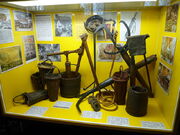
Fire fighting tools in Germany. Note the picture of a hand squirt (rear wall on right side), one of the most ancient devices for applying water to a fire.
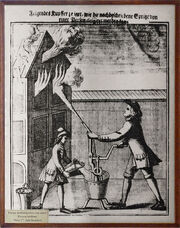
One of the simplest forms of hand tub type fire engines, engraving from the mid 17th century in Germany
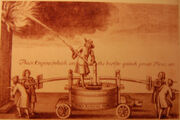
Illustration of a 1670s fire engine (pumper) made in London by John Keeling of Blackfriars. Note the nozzle is mounted to the engine; later nozzles were mounted to hoses. Also, the earliest engines wheels do not turn to the side, the men moving the engine to the fire would forcibly change the direction of the engine as needed.
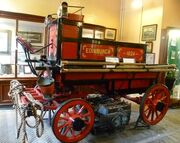
Manually drawn fire pump in service in Edinburgh in 1824.
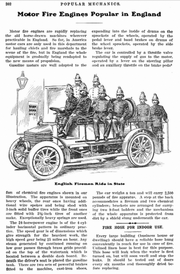
A 1905 article in the magazine Popular Mechanics described the motorization of fire engines that was advancing rapidly in England and would soon occur elsewhere in Europe and North America.
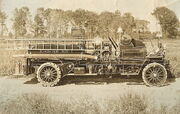
A Knox fire engine, one of the first modern fire engines, manufactured in 1905 in Springfield, Massachusetts by the Knox Automobile Company.
An early device used to squirt water onto a fire is a squirt or fire syringe. Hand squirts and hand pumps are noted before Ctesibius of Alexandria invented the first fire pump around the 2nd century B.C.,[27] and an example of a force-pump possibly used for a fire-engine is mentioned by Heron of Alexandria. The fire pump was reinvented in Europe during the 16th century, reportedly used in Augsburg in 1518 and Nuremberg in 1657. A book of 1655 inventions mentions a steam engine (called a fire engine) pump used to "raise a column of water 40 feet [12 m]", but there was no mention of whether it was portable.
Colonial laws in America required each house to have a bucket of water on the front stoop during fires at night. These buckets were intended for use by the initial bucket brigade that would supply the water at fires. Philadelphia obtained a hand-pumped fire engine in 1719, years after Boston's 1654 model appeared there, made by Joseph Jencks, but before New York's two engines arrived from London.
By 1730, Richard Newsham, in London, had made successful fire engines; the first used in New York City (in 1731) were of his make (six years before formation of the NYC volunteer fire department). The amount of manpower and skill necessary for firefighting prompted the institution of an organized fire company by Benjamin Franklin in 1737. Thomas Lote built the first fire engine made in America in 1743. These earliest engines are called hand tubs because they are manually (hand) powered and the water was supplied by bucket brigade dumped into a tub (cistern) where the pump had a permanent intake pipe. An important advancement around 1822 was the invention of an engine which could draft water from a water source doing away with the bucket brigade. Philadelphia fire engine manufacturers Sellers and Pennock model the Hydraulion is said to be the first suction engine produced in 1822.[28] Some models had the hard, suction hose fixed to the intake and curled up over the apparatus known as a squirrel tail engine.
The earliest engines were small and were carried by four men or mounted on skids and dragged to a fire. The earliest four-wheel carriage mounted engines were pulled to the fire by hand. As the engines grew larger they became horse-drawn and later self-propelled by steam engines. John Ericsson is credited with building the first American steam-powered fire engine. George Braithwaite built the first steam fire-engine in Britain.
Until the mid-19th century, most fire engines were maneuvered by men, but the introduction of horse-drawn fire engines considerably improved the response time to incidents. The first self-propelled steam-driven fire engine was built in New York in 1841. It was the target of sabotage by firefighters and its use was discontinued, and motorized fire engines did not become commonplace until the early 20th century. By 1905, the idea of combining gas engine motor trucks into fire engines was attracting great attention; according to a Popular Mechanics article in that year,[29] such trucks were rapidly gaining popularity in England. That same year, the Knox Automobile Company of Springfield, Massachusetts began selling what some[30] have described as the world's first modern fire engine. A year later, the City of Springfield had an entire modern fire department supplied with Knox fire engines.
For many years firefighters sat on the sides of the fire engines, or even stood on the rear of the vehicles, exposed to the elements. This arrangement was uncomfortable and dangerous (some firefighters were thrown to their deaths when their fire engines made sharp turns on the road), and today nearly all fire engines have fully enclosed seating areas for their crews.
Early pumpers[]
Early pumpers used cisterns as a source of water. Water was later put into wooden pipes under the streets and a "fire plug" was pulled out of the top of the pipe when a suction hose was to be inserted. Later systems incorporated pressurized fire hydrants, where the pressure was increased when a fire alarm was sounded. This was found to be harmful to the system, and unreliable, and today's valved hydrant systems are kept under pressure at all times, although additional pressure may be added when needed. Pressurized hydrants eliminate much of the work in obtaining water for pumping through the engine and into the attack hoses. Many rural fire engines still rely upon cisterns or other sources for drafting water into the pumps.
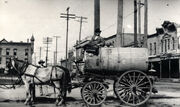
An unidentified man poses in the driver's seat of a horse-drawn water wagon.
Early aerials[]
Since the late 19th century, means of reaching tall structures have been devised. At first, manually extendable ladders were used; as these grew in length (and weight), they were put onto two large wheels. When carried by fire engines these ladders had the wheels suspended behind the rear of the vehicle, making them a distinctive sight. Before long, the turntable ladder—which was even longer, mechanically extendable, and installed directly onto a fire truck—made its appearance.
The longest turntable ladders have reached a height of 150 feet ( m), requiring the aforementioned "tiller trucks" to carry such ladders.
After the Second World War turntable ladders were supplemented by the aerial work platform (sometimes called "cherry picker"), a platform or bucket attached onto a mechanically bending arm (or "snorkel") installed onto a fire truck. While these could not reach the height of similar turntable ladders, the platforms could extend into previously unreachable "dead corners" of a burning building.
See also[]
Lua error: bad argument #2 to 'title.new' (unrecognized namespace name 'Portal').
- Fire appliances in the United Kingdom
- Fire chief's vehicle
- Glossary of firefighting terms
- Containerized firefighting equipment
- Jan van der Heyden, improved the design of the fire engine in 1672
- NFPA 1901
References[]
- ↑ "Fire Fighting Technologies detail on IFES". http://www.ffti.com.au/product_detail/36/. Retrieved 2007-06-15.
- ↑ As reported during interviews with retired Lawrence, MA firefighters Robert K. White and Thomas S. Bailey, on April 19, 1997
- ↑ Bronto Skylift: HLA Range brochure. www.bronto.fi. Retrieved December 5, 2012
- ↑ "Russian plane delivers American pump to Japan". .the news tribune. April 2011. http://www.thenewstribune.com/2011/04/09/1619190/russian-plane-delivers-american.html. Retrieved 9 April 2011.
- ↑ NFPA 1006 Standard for Rescue Technician Professional Qualifications. 2003 Edition. National Fire Protection Association.
- ↑ NFPA 1670 Standard on Operations and Training for Technical Search and Rescue Incidents. 2004 Edition. National Fire Protection Association.
- ↑ For example, Helsinki City Transport's tram rescue unit in Fireimages.net, retrieved May 9, 2007.
- ↑ For example, VR railway rescue squad in Fireimages, retrieved May 9, 2007.
- ↑ Visiiri 2/2006, pp. 6 – 7, on the heavy rescue unit of VR Railway Company in Helsinki, Finland, Liitin Oy, retrieved May 9, 2007. (Finnish)
- ↑ "Engine Types". National Wildfire Coordinating Group. http://www.nwcg.gov/general/memos/nwcg-006-2008.pdf. Retrieved 5 January 2014.
- ↑ "Type 3 Engine". Santa Barbara County Fire. http://sbcfire.ndic.com/wp-content/uploads/2012/05/Type-3-Engine.pdf. Retrieved 2930December 2013.
- ↑ Helsinki Rescue Department
- ↑ NFPA 1901 Standard for Automotive Fire Apparatus, Chapter 7: Mobile Water Supply Fire Apparatus. 2003 edition. National Fire Protection Association.
- ↑ Tarvasjoen vpk (Tarvasjoki Voluntary Fire Dept, Finland 2006)
- ↑ For example, specifications of Amthor International Fire Tankers, www.amthorinternational.com, retrieved April 28, 2007
- ↑ Example on a 12,500 litres (Template:Convert/USgal impgal) water tender with 9,000 litres (Template:Convert/USgal impgal) trailer: Fire Dept. of Kittilä, Regional Rescue Services of Lappi in northern Finland. Fireimages.net, retrieved April 28, 2007.
- ↑ "Просмотр фотографии". Archive.is. http://archive.is/20130131124553/http://www.parovoz.com/newgallery/pg_view.php?ID=240297&LNG=RU%23picture. Retrieved 2013-12-04.
- ↑ "Fighting fire with a trainWildfire Today". Wildfiretoday.com. 2010-08-24. http://wildfiretoday.com/2010/08/24/fighting-fire-with-a-train/. Retrieved 2011-10-24.
- ↑ Relyea; Robert G., Garnett; Edward V.: United States Patent Application, February 8, 1993. United States Patent and Trademark Office
- ↑ ICAO: Volume 1 - Aerodrome Design and Operations. Annex 14: Aerodrome Rescue and Fire Fighting Service (RFFS) requirements
- ↑ ICAO: Airport Services Manual. Part 1 - Rescue and Fire Fighting. 3rd edition, 1990
- ↑ August 3, 2002, China Develops First Urban Fire-fighting Tank, Xinhua News Agency
- ↑ Walter A, Edgar C, Rutledge M: First Responder Handbook: Fire Service Edition.
- ↑ Alaspää et al.: Uusi ensihoidon käsikirja. Tammi 2004. (New Handbook on Emergency care) (Finnish)
- ↑ "Riekerinc.com". Riekerinc.com. http://www.riekerinc.com/Boom%20Angle%20Indicators/4120wwl12v.htm. Retrieved 2013-12-04.
- ↑ Pelastusajoneuvojen yleisopas. (A general guide for rescue vehicles) (In Finnish). Ministry of the Interior, Finland. Pelastustoimi.fi (Finnish) , Retrieved April 28, 2007
- ↑ Young, Charles Frederick T.. Fires, fire engines, and fire brigades: with a history of manual and steam fire engines, their construction, use, and management; remarks on fire-proof buildings ... statistics of the fire appliances in English towns; foreign fire systems; hints for the f. London: Lockwood & Co., 1866. 335. Print.]
- ↑ Rorer, Beverly, and Barbara Marinelli. Images of America: Upper Darby. Charleston, S.C.: Arcadia Pub., 2011. 112. Print.
- ↑ Lua error in package.lua at line 80: module 'Module:Citation/CS1/Configuration' not found.
- ↑ "Books about Knox Automobile Company - Historical Photos & Images of Knox Automobile Company". Arcadia Publishing. http://www.arcadiapublishing.com/mm5/merchant.mvc?Screen=PROD&Product_Code=9780738504995&Store_Code=arcadia&search=MA&offset=100&filter_cat=&PowerSearch_Begin_Only=&sort=&range_low=&range_high=%20%26srch_state%3D1. Retrieved 2011-10-24.
External links[]
| Wikimedia Commons has media related to: Fire engine |
- Handtub Junction, USA Website about handtubs in the U.S. including a database of all known apparatus.